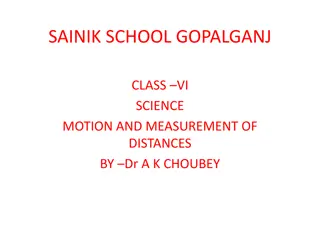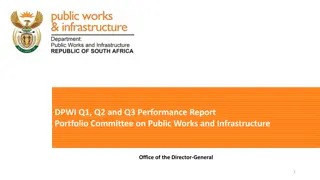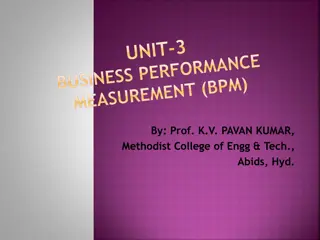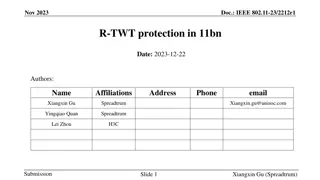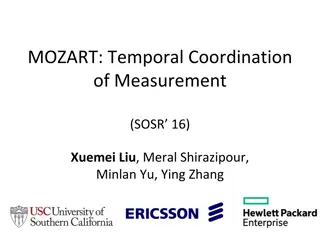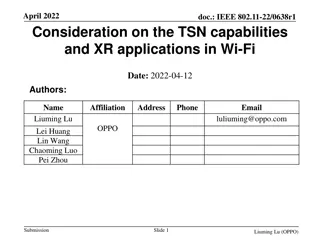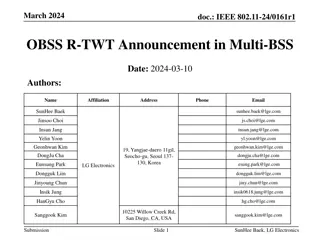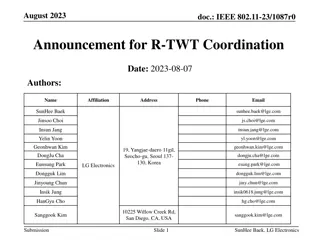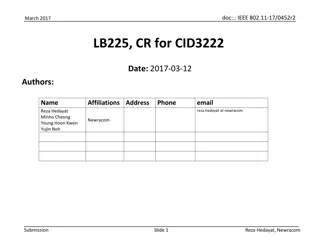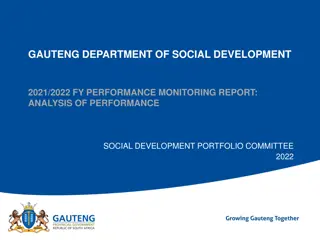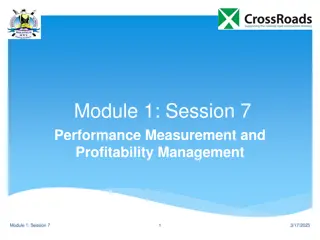
Improving Multicast Performance in Wireless Networks
Explore the potential enhancements in multicast performance through innovative mechanisms for BAR destination selection in IEEE 802.11 wireless networks. Suggestions include optimizing the number of BAR destinations and implementing efficient reporting mechanisms to boost reliability for multicast applications.
Download Presentation

Please find below an Image/Link to download the presentation.
The content on the website is provided AS IS for your information and personal use only. It may not be sold, licensed, or shared on other websites without obtaining consent from the author. If you encounter any issues during the download, it is possible that the publisher has removed the file from their server.
You are allowed to download the files provided on this website for personal or commercial use, subject to the condition that they are used lawfully. All files are the property of their respective owners.
The content on the website is provided AS IS for your information and personal use only. It may not be sold, licensed, or shared on other websites without obtaining consent from the author.
E N D
Presentation Transcript
March 2015 GCR-BA Performance with Measurement Report in OBSS Date: 2015/03/09 doc.: IEEE 802.11-15/0320r1 Authors: Name Yusuke Tanaka Affiliations Address Sony Corp. Phone email YusukeC.Tanaka@jp.sony.com Eisuke Sakai Sony Corp Eisuke.Sakai@jp.sony.com Yuichi Morioka Sony Corp Yuichi.Morioka@jp.sony.com Masahito Mori Sony Corp Masahito.Mori@jp.sony.com William.Carney@am.sony.com William Carney Sony Corp Submission Slide 1 Yusuke Tanaka, Sony Corporation
March 2015 doc.: IEEE 802.11-15/0320r1 Abstract Previous submission[1] showed that if the BAR(Block Ack Request) Destination is selected appropriately by throughput characteristics, the multicast performance improves. It also suggested that the number of BAR Destinations should be optimized. This submission shows that the use of existing frames to identify the optimal BAR Destinations will degrade the overall performance due to significant overhead. This submission concludes that a more efficient mechanism is necessary to ensure the reliability for multicast applications. Submission Slide 2 Yusuke Tanaka, Sony Corporation
March 2015 doc.: IEEE 802.11-15/0320r1 Recap [1] Worst TP selection outperforms Random selection when appropriate number of BAR Destinations are selected. AP needs a mechanism to identify underperforming STAs to determine BAR Destinations. Performance improves due to proper retransmission Random selection Worst TP selection Target PLR for video applications Performance degrades due to too much retransmission Submission Slide 3 Yusuke Tanaka, Sony Corporation
March 2015 doc.: IEEE 802.11-15/0320r1 Determination of BAR Destination by an existing method 802.11v (now merged into [2]) has introduced a mechanism to collect STAs' throughput information by a frame called Multicast Diagnostic Report (MD Report). AP can identify underperforming STAs to determine BAR Destinations through collection of this MD Reports from all STAs. Fig1. Measurement Report field format for a Multicast Diagnostics Report Submission Slide 4 Yusuke Tanaka, Sony Corporation
March 2015 doc.: IEEE 802.11-15/0320r1 Frequency of Reporting For optimal BAR Destination (re-)selection, MD report is preferable to be sent no more than BAR interval. When multicast traffic is transmitted at 3 Mbps, BAR would be transmitted at least every 250 msec in this scenario. (1500 [byte/packet] * 8 [bit/byte]) * 64 [packet] / 3 [Mbit /sec] = 256 [msec] BAR should be sent at least once out of 64packets. System performance using MD Report to identify BAR Destination is simulated. Submission Slide 5 Yusuke Tanaka, Sony Corporation
March 2015 doc.: IEEE 802.11-15/0320r1 Simulation Conditions Scenario-3 19-cell model with wrap-around (Reuse=3) Traffic model Multicast downlink UDP Flow (3Mbps)/BSS All APs broadcast same contents 30 STAs/BSS are receiving multicast 10 uplink UDP Flows(300kbps)/BSS # of BAR Destinations /BSS 0, 1, 2, 3, 4, 5, 10, 20, 30 (all STAs receives BAR) Selection of BAR Destinations In order of bad throughput Overhead With MD report overhead per 250 msec from All STAs Without MD report overhead, but optimal selection PHY rate Data frames = 585Mbps (MCS = 7, 80MHz, 2SS) BAR/BA/MD report = 6Mbps (MCS = 0, with legacy format) More details are shown in appendix. Submission Slide 6 Yusuke Tanaka, Sony Corporation
March 2015 doc.: IEEE 802.11-15/0320r1 Simulation Results in SS3 (PLR) The performance degrades due to MD report overhead as compared to the performance without overhead. The performance can be improved if the overhead can be reduced. Degradation due to MD report overhead With MD report overhead Without overhead Target PLR for video applications Submission Slide 7 Yusuke Tanaka, Sony Corporation
March 2015 doc.: IEEE 802.11-15/0320r1 Conclusions This submission showed GCR-BA performance with throughput selection by MD report from all STAs. The overhead of the MD report is not negligible, therefore the entire performance degrades as compared to the performance without such overhead. To improve the performance of GCR BA, an effective mechanism is needed to reduce the overhead in selection of proper STAs. Submission Slide 8 Yusuke Tanaka, Sony Corporation
March 2015 doc.: IEEE 802.11-15/0320r1 References 1. Eisuke Sakai, Sony, 11-15-0046-00 11aa GCR-BA Performance in OBSS 2. IEEE Std. 802.11-2012 3. Simone Merlin, Qualcomm, 11-14-0980-06 TGax Simulation Scenarios 4. IEEE Std. 802.11aa Submission Slide 9 Yusuke Tanaka, Sony Corporation
March 2015 doc.: IEEE 802.11-15/0320r1 BACKUP Submission Slide 10 Yusuke Tanaka, Sony Corporation
March 2015 doc.: IEEE 802.11-15/0320r1 (AP x 1, STA x 40) x 19 Node Simulation Setup details Downlink CBR UDP 3 Mbps (from all AP) Uplink CBR UDP 300 kbps (from 10 of 40 STAs, not multicast receiving STAs) 1 Num of Drops [times] Traffic Model & Load 39 Traffic Duration [sec] AC_BE CWmin=15, CWmax=1023, AIFSN=3, TXOP limit=0 Access Category AP:+23dBm (2 antennas), STA:+15dBm (Single antenna) Tx Power [dBm] Fixed (Legacy 6Mbps for BAR/BA/MD Report, MCS7, with HT80 and 2SS, for data frames) MCS Selection (MPDU, MSDU, APP)=(1530, 1500, 1464) Fixed Packet Length [byte] 10 L2 Retry Legacy 6.0Mbps Ack Rate OFF RTS/CTS A-MPDU, A-MSDU)=(64KB, NA) Max Aggregation Size 7 NF [dB] TGn Channel D (pathloss, shadowing, fading) Channel (CenterFreq, BW)=(5180, 80) Channel Setting [MHz] Enable (Error performance is shown in next slide) Det. Cancel on PLCP err (0, 3) for AP, (-2, 1.5) for STA Antenna settings(Gain [dBi, Height [m] 375 Tx buffer size [kB] 1 TTL [sec] Worst TP BAR receiving STAs selction (None, transmitted every 250msec from each STA) Multicast Diagnostic Report Overhead Enabled Wraparound (CCA-SD, CCA-ED) = (-82, -62) [NOTE] The term CCA-ED represents 20 dB above the minimum modulation and coding rate sensitivity in this material. Sensitivity level [dBm] Submission Slide 11 Yusuke Tanaka, Sony Corporation
March 2015 doc.: IEEE 802.11-15/0320r1 Prob. of PLCP Success Submission Slide 12 Yusuke Tanaka, Sony Corporation
March 2015 doc.: IEEE 802.11-15/0320r1 Target PLR on Wireless System for Multicast = 2E -2 When utilizing (B, N) = (30, 5), Target PLR = 2E-2 B :Block length, N: Parity length Code rate = (B-N)/B Required PLR on application Solid line : Code Rate = 5/6 Dashed line : Code Rate = 2/3 Submission Slide 13 Yusuke Tanaka, Sony Corporation


